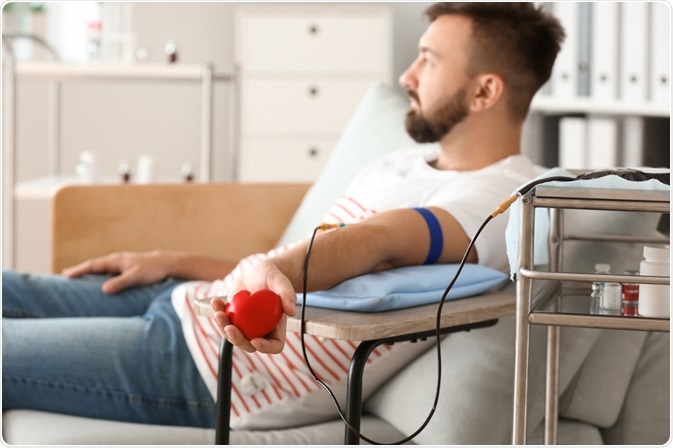Donating blood and blood products saves lives by providing essential support to emergency medicine and people with long-term conditions, and a single blood donation may save the lives of three people. It is estimated that across the United States, approximately 36,000 units of red blood cells are required daily. In 2011 alone, almost 21 million blood products were transfused.

Blood Donation. Image Credit: Pixel-Shot/Shutterstock.com
The demand for blood donation
Blood donations are used to treat multiple medical conditions. Usually separated into the component parts of red blood cells, plasma, and platelets, this maximizes each blood donation as each component can be used to treat a different patient.
Donated blood products are given to patients via transfusion, whereby blood is delivered into a blood vessel using an intravenous line. Approximately two-thirds of blood donations are used to treat medical conditions such as cancer, anemia, and blood disorders. The remaining third is used during surgeries and emergencies. Blood transfusions are also given to terminally ill patients to improve their quality of life.
As medical technologies such as surgical interventions and plasma-derived pharmaceuticals develop, the demand for blood donations has also grown. Estimates put this growth in demand at 2-3% per year, but at the same time, the available pool of people eligible to provide blood donations is declining.
Donating blood is a straightforward procedure that is completely safe for healthy adults and is conducted under sterile conditions. All blood transfusion services require donors to complete a 4-stage process, to ensure the safety of both the donor and the recipient.
Registration
Involves signing up with a local or national transfusion service, and usually requires the completion of a short screening questionnaire to ensure basic eligibility for donation before making an appointment to donate.
Health screening
A more in-depth physical screening involving taking the pulse, blood pressure, and temperature. In some areas, a pre-donation anemia test will be conducted. Potential donors will also be asked to provide information about their lifestyle, general health, and recent travel to minimize the risk of providing a sample with a blood-transmissible infection.
Donation
Once the health screening checks have been completed satisfactorily, a phlebotomist inserts a needle into a viable vein and the donation process can begin. Approximately one pint of blood is collected during each donation, which takes about 10 minutes. Donations are tested for the presence of blood-transmissible infections such as HIV and hepatitis.
Aftercare
Donors are asked to remain at the donor center for about ten minutes once the blood collection is complete. They are provided with refreshments and monitored for adverse effects of donating.
The need for diversity in donors
Transfusion services need to ensure they have access to a sustainable supply of various blood types, to meet the needs of the diverse population of patients who require blood products. The types of blood and the associated demand for them varies regionally and nationally, but overall certain blood types are always more in demand than others. This is because blood types are categorized according to the presence and absence of different antibodies and antigens, meaning that the suitability of the donor blood must be matched to the recipient.
It is also crucial that transfusion services maintain supplies of certain blood types, which are rare to possess as a donor, but frequently in demand by recipients. One example is the Ro subtype, which is a variation of the Rh-positive blood type and is used to treat a group of hereditary blood disorders known as sickle cell. In sickle cell disorders, red blood cells are misshapen and block small blood vessels. It is treated via 4-6 weekly transfusions of Ro blood. Demand for this subtype is growing by 15% per year, but only 2% of donors fall into this group.
It is an urgent priority for transfusion services to increase the number of people from Black, Asian, and minority ethnic backgrounds who donate blood. This is partly to support patients who require certain blood subtypes such as the Ro subtype, and partly because the prevalence of blood types, including the rarer blood types, associated with ethnicity.
For example, Black and African/Caribbean donors are ten times more likely to have B positive and the Ro subtype than White donors. Moreover, it has been well established that matching donors and recipients by phenotype, including ethnicity, greatly increases the success of successful transfusion.
Blood donations during COVID-19
The requirement for donated blood and blood products is constant, and as such, most transfusion centers have remained open during the pandemic. To maintain the safety of donors and healthcare staff, additional safety precautions including additional cleaning and social distancing protocols have been put in place. Transfusions services that operated as ‘drop-in’ services may have implemented appointment-only donation sessions.
Many transfusion services are screening all blood, platelet, and plasma donations for COVID-19 antibodies with the aim of treating severe cases of COVID-19 with convalescent plasma. Recent research has evaluated the clinical effectiveness of using plasma with very high COVID-19 antibody levels. Early results indicated that receiving plasma with high levels of antibodies significantly reduced mortality from COVID-19 if delivered within an optimal 44-hour window post-hospitalization.
References:
- Duan, K., Liu, B., Li, C., Zhang, H., Yu, T., Qu, J., Zhou, M., Chen, L., Meng, S., Hu, Y., Peng, C., Yuan, M., Huang, J., Wang, Z., Yu, J., Gao, X., Wang, D., Yu, X., Li, L., Zhang, J., … Yang, X. (2020). Effectiveness of convalescent plasma therapy in severe COVID-19 patients. Proceedings of the National Academy of Sciences of the United States of America, 117(17), 9490–9496. https://doi.org/10.1073/pnas.2004168117.
- MacIntyre, L. M. (2017). The Growing Need for Diverse Blood Donors. AJN, American Journal of Nursing, 117(7), 44–48. doi: 10.1097/01.NAJ.0000520945.31600.3f.
- https://www.blood.co.uk/the-donation-process/what-happens-on-the-day/
Further Reading
Last Updated: Jan 17, 2022